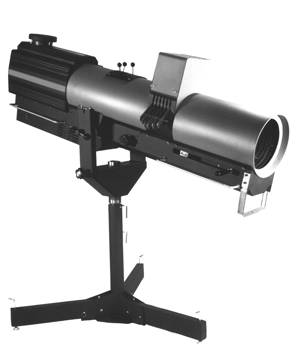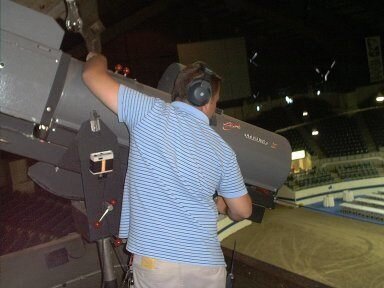(Also often written as: follow spot, follow spotlight, or follow spot light.)
A large, operator-driven lighting instrument used to follow a key performer around the stage. Most commonly seen in musicals and in rock shows. Also referred to by laymen as a spotlight, although that terms also applies to ERSs/Fresnels, etc.. There are many variations of follow spots designed for different venues, throw distances, and uses.
Most follow spots have the same basic features. All follow spots include an Iris which is usually operated via a handle on the top of the spot. The iris can change the size of the beam from a small head-shot to a large beam covering multiple performers.
All follow spots also have a douser which is used to vary the intensity of the light as well as make the beam appear and disappear on the stage. In most cases, the lamp of the follow spot is left on while the douser is used to regulate the light actually coming out of the spot.
Most spots also have a Boomerang, which is a device on the front of the spot that holds up to 6 color gels. These can be added into the beam to change the color and, in the case of a frost, texture, of the spot. Most shows will include at least one frost (such as R119) in the boomerang to allow the spot to blend in better with the rest of the lighting when that is the desired effect.
Most spots also have a chopper, which is a set of two shutters that come in only on the top and bottom of the beam to cut off unwanted light. These are most useful when trying to spot a line of people without spilling light into the pit or upstage onto the scenery. Some, most notably most of Robert Juliat models, also have a set of vertical shutters.

This is a Lycian Model 1290 XLT Follow Spot, a very popular spot used in theatres with a medium to long throw distances. It is equipped with a 2000W Xenon lamp, giving it a higher color temperature and allowing it to stand out from the rest of the rig. The levers on the top of the spot are (from front to back): the douser, the iris, and the chopper. The handles in the tallest portion of the spot make up the boomerang. Each handle controls one color frame which holds a cut of gel or diffusion. The frames are in the beam when the handle is up.

This is a Source Four 5° instrument equipped with a partial City Theatrical follow spot package; also known as a "Source-Four-on-a-stick". Any SourceFour fixture can be adapted, with focal length dependent on throw distance. This photo shows only the base and the spot handles, however the full package also includes a manual boomerang and a manual iris which work with the instrument. The Source-Four-on-a-stick is small and so is well suited to tight locations such as catwalks. It provides the advantage of matching color temperature with the rest of the rig, as well as allowing the spot intensity to be dimmed from the lighting board, ensuring accurate pickup times and fades. It also uses instruments and lamps which are already in the theatre's inventory, meaning that the long-term maintenance costs will be much less. A further benefit is, when not needed as a followspot, it can function as a regular ERS fixture.
Typical stance for operating a longer-throw fixture:

http://www.iatse30.org/images/ISF_06_Andy_at_spot.JPG
YouTube video of a Brit demonstrating a long throw followspot at the National Theatre:
http://www.youtube.com/watch?NR=1&feature=endscreen&v=9uc8t4k07fM
For operational tips, see this site: 10 Commandments for Spotlight Operators (just ignore the references to carbon-arc sources).
A large, operator-driven lighting instrument used to follow a key performer around the stage. Most commonly seen in musicals and in rock shows. Also referred to by laymen as a spotlight, although that terms also applies to ERSs/Fresnels, etc.. There are many variations of follow spots designed for different venues, throw distances, and uses.
Most follow spots have the same basic features. All follow spots include an Iris which is usually operated via a handle on the top of the spot. The iris can change the size of the beam from a small head-shot to a large beam covering multiple performers.
All follow spots also have a douser which is used to vary the intensity of the light as well as make the beam appear and disappear on the stage. In most cases, the lamp of the follow spot is left on while the douser is used to regulate the light actually coming out of the spot.
Most spots also have a Boomerang, which is a device on the front of the spot that holds up to 6 color gels. These can be added into the beam to change the color and, in the case of a frost, texture, of the spot. Most shows will include at least one frost (such as R119) in the boomerang to allow the spot to blend in better with the rest of the lighting when that is the desired effect.
Most spots also have a chopper, which is a set of two shutters that come in only on the top and bottom of the beam to cut off unwanted light. These are most useful when trying to spot a line of people without spilling light into the pit or upstage onto the scenery. Some, most notably most of Robert Juliat models, also have a set of vertical shutters.

This is a Lycian Model 1290 XLT Follow Spot, a very popular spot used in theatres with a medium to long throw distances. It is equipped with a 2000W Xenon lamp, giving it a higher color temperature and allowing it to stand out from the rest of the rig. The levers on the top of the spot are (from front to back): the douser, the iris, and the chopper. The handles in the tallest portion of the spot make up the boomerang. Each handle controls one color frame which holds a cut of gel or diffusion. The frames are in the beam when the handle is up.

This is a Source Four 5° instrument equipped with a partial City Theatrical follow spot package; also known as a "Source-Four-on-a-stick". Any SourceFour fixture can be adapted, with focal length dependent on throw distance. This photo shows only the base and the spot handles, however the full package also includes a manual boomerang and a manual iris which work with the instrument. The Source-Four-on-a-stick is small and so is well suited to tight locations such as catwalks. It provides the advantage of matching color temperature with the rest of the rig, as well as allowing the spot intensity to be dimmed from the lighting board, ensuring accurate pickup times and fades. It also uses instruments and lamps which are already in the theatre's inventory, meaning that the long-term maintenance costs will be much less. A further benefit is, when not needed as a followspot, it can function as a regular ERS fixture.
Typical stance for operating a longer-throw fixture:

http://www.iatse30.org/images/ISF_06_Andy_at_spot.JPG
YouTube video of a Brit demonstrating a long throw followspot at the National Theatre:
http://www.youtube.com/watch?NR=1&feature=endscreen&v=9uc8t4k07fM
For operational tips, see this site: 10 Commandments for Spotlight Operators (just ignore the references to carbon-arc sources).
Last edited by a moderator:


